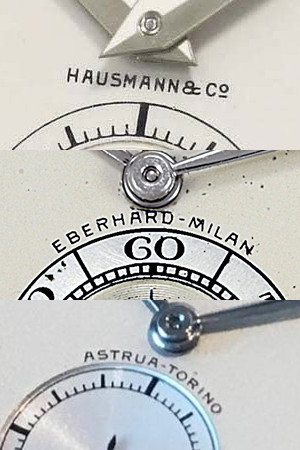Most all known Patek Philippe steel 570 pieces are unique in design combination of dial, hands and marks.
The following highlights the most prominent elements of dials seen.
Regarding dial color, we see groupings as follows.
Colors
– Silvered
– Two or three-tone silvered
– Some dials appear white in color, though given the frequency of silvered dials, this may simply be due to the photograph (in the case number project I have noted dials as “white” when appears as so, if no other indication of color is provided)
– There are some unusual colors seen, including a pink/copper-ish three-tone dial, which likely began its life silvered, and a caramel colored dial, which I would guess is another aged silver dial. The black dial seen is a replacement.
Numerals, marks and seconds register
– A large number of dials feature a Breguet style numerals, nearly all applied Arabic, with one example of black enameled numerals. When Breguet numerals are used, they appear at each hour, generally with the exception of at 6. Two examples do have a cropped-6.
– Approximately the same number of dials have Arabic numbers not in Breguet style. There are two general styles of these dials:
— Numerals shown at 3, 6, 9 and 12, unless the watch has subsidiary seconds, in which case none is shown at 6. These dials have baton marks (short or long applied, or enameled) for the other hours.
— Numerals at 2, 4, 8, 10 and 12. These dials all have plots of the other hour marks.
– Only a couple of dials have Roman numerals, at 3, 6 (if indirect seconds), 9 and 12. The two pieces are completely different in design (marks, outer track, center v subsidiary).
– Last, there are few dials with no numerals, and simple single pointed baton index marks at each hour (with a pair at 12 o’clock), cropped at 6 due to the subsidiary register.

Outer minute track
Outer tracks come in a few different varieties:
[images to come]
– plots
– minute marks, thicker on the 5s, both with and without numerals
– railroad tracks, no numerals, lines connecting the rings at each minute, thicker on the 5s
– railroad tracks, numerals on the 5s with short thick marks within the track, lines connecting the rings at each minute, with short marks at 1/5.
– railroad tracks with lines connecting at the 5s, and dots at each minute within the track; numerals are at the outside of the outer ring on the 15s
Subsidiary seconds
I have seen a handful of indirect center seconds pieces, with the vast majority utilizing a subsidiary seconds register.

Subsidiary designs include:
– multiple rings featuring a railroad-style design for the two “inner” rings, numerals on the 10s
– simplified closed register with two outer rings, featuring thick marks extending to both rings on the 15s, slightly less thick marks on the 5s extending about 2/3 of the way to the outer ring, and shorter minute marks (one piece has only 5-minute marks, which extend between rings)
– open register
Dials with Breguet numerals are generally the only dials that have registers with numerals, though we see a single example without Breguet numerals.
There can be slight differences in design within one type, such as slightly differing length of 5-second marks.
Signature and retailer
We see two manufacture signatures centered horizontally on the top half of the dial:
‘PATEK, PHILIPPE & Co.’ and ‘PATEK PHILIPPE’
Regardless of which is shown, we see GENÈVE below.
One curious dial has a short underline below GENEVE. Though curiously it lacks the È mark in GENÈVE, and it is unclear if there is a comma between PATEK and PHILIPPE. I do not believe pieces were ever signed PATEK PHILIPPE & Co., but would rather show without the comma due to a reprinted dial, or excessive cleaning.
I have seen three retailer signatures on the Patek Philippe 570 in stainless steel:
HAUSMANN & Co
EBERHARD – MILAN
ASTRUA – TORINO

